Won-Joo Hwang
Quantum Annealing-Based Sum Rate Maximization for Multi-UAV-Aided Wireless Networks
Feb 25, 2025Abstract:In wireless communication networks, it is difficult to solve many NP-hard problems owing to computational complexity and high cost. Recently, quantum annealing (QA) based on quantum physics was introduced as a key enabler for solving optimization problems quickly. However, only some studies consider quantum-based approaches in wireless communications. Therefore, we investigate the performance of a QA solution to an optimization problem in wireless networks. Specifically, we aim to maximize the sum rate by jointly optimizing clustering, sub-channel assignment, and power allocation in a multi-unmanned aerial vehicle-aided wireless network. We formulate the sum rate maximization problem as a combinatorial optimization problem. Then, we divide it into two sub-problems: 1) a QA-based clustering and 2) sub-channel assignment and power allocation for a given clustering configuration. Subsequently, we obtain an optimized solution for the joint optimization problem by solving these two sub-problems. For the first sub-problem, we convert the problem into a simplified quadratic unconstrained binary optimization (QUBO) model. As for the second sub-problem, we introduce a novel QA algorithm with optimal scaling parameters to address it. Simulation results demonstrate the effectiveness of the proposed algorithm in terms of the sum rate and running time.
Applications of Distributed Machine Learning for the Internet-of-Things: A Comprehensive Survey
Oct 16, 2023Abstract:The emergence of new services and applications in emerging wireless networks (e.g., beyond 5G and 6G) has shown a growing demand for the usage of artificial intelligence (AI) in the Internet of Things (IoT). However, the proliferation of massive IoT connections and the availability of computing resources distributed across future IoT systems have strongly demanded the development of distributed AI for better IoT services and applications. Therefore, existing AI-enabled IoT systems can be enhanced by implementing distributed machine learning (aka distributed learning) approaches. This work aims to provide a comprehensive survey on distributed learning for IoT services and applications in emerging networks. In particular, we first provide a background of machine learning and present a preliminary to typical distributed learning approaches, such as federated learning, multi-agent reinforcement learning, and distributed inference. Then, we provide an extensive review of distributed learning for critical IoT services (e.g., data sharing and computation offloading, localization, mobile crowdsensing, and security and privacy) and IoT applications (e.g., smart healthcare, smart grid, autonomous vehicle, aerial IoT networks, and smart industry). From the reviewed literature, we also present critical challenges of distributed learning for IoT and propose several promising solutions and research directions in this emerging area.
Joint Communication and Computation Framework for Goal-Oriented Semantic Communication with Distortion Rate Resilience
Sep 26, 2023Abstract:Recent research efforts on semantic communication have mostly considered accuracy as a main problem for optimizing goal-oriented communication systems. However, these approaches introduce a paradox: the accuracy of artificial intelligence (AI) tasks should naturally emerge through training rather than being dictated by network constraints. Acknowledging this dilemma, this work introduces an innovative approach that leverages the rate-distortion theory to analyze distortions induced by communication and semantic compression, thereby analyzing the learning process. Specifically, we examine the distribution shift between the original data and the distorted data, thus assessing its impact on the AI model's performance. Founding upon this analysis, we can preemptively estimate the empirical accuracy of AI tasks, making the goal-oriented semantic communication problem feasible. To achieve this objective, we present the theoretical foundation of our approach, accompanied by simulations and experiments that demonstrate its effectiveness. The experimental results indicate that our proposed method enables accurate AI task performance while adhering to network constraints, establishing it as a valuable contribution to the field of signal processing. Furthermore, this work advances research in goal-oriented semantic communication and highlights the significance of data-driven approaches in optimizing the performance of intelligent systems.
Wirelessly Powered Federated Learning Networks: Joint Power Transfer, Data Sensing, Model Training, and Resource Allocation
Aug 09, 2023Abstract:Federated learning (FL) has found many successes in wireless networks; however, the implementation of FL has been hindered by the energy limitation of mobile devices (MDs) and the availability of training data at MDs. How to integrate wireless power transfer and mobile crowdsensing towards sustainable FL solutions is a research topic entirely missing from the open literature. This work for the first time investigates a resource allocation problem in collaborative sensing-assisted sustainable FL (S2FL) networks with the goal of minimizing the total completion time. We investigate a practical harvesting-sensing-training-transmitting protocol in which energy-limited MDs first harvest energy from RF signals, use it to gain a reward for user participation, sense the training data from the environment, train the local models at MDs, and transmit the model updates to the server. The total completion time minimization problem of jointly optimizing power transfer, transmit power allocation, data sensing, bandwidth allocation, local model training, and data transmission is complicated due to the non-convex objective function, highly non-convex constraints, and strongly coupled variables. We propose a computationally-efficient path-following algorithm to obtain the optimal solution via the decomposition technique. In particular, inner convex approximations are developed for the resource allocation subproblem, and the subproblems are performed alternatively in an iterative fashion. Simulation results are provided to evaluate the effectiveness of the proposed S2FL algorithm in reducing the completion time up to 21.45% in comparison with other benchmark schemes. Further, we investigate an extension of our work from frequency division multiple access (FDMA) to non-orthogonal multiple access (NOMA) and show that NOMA can speed up the total completion time 8.36% on average of the considered FL system.
Label driven Knowledge Distillation for Federated Learning with non-IID Data
Sep 30, 2022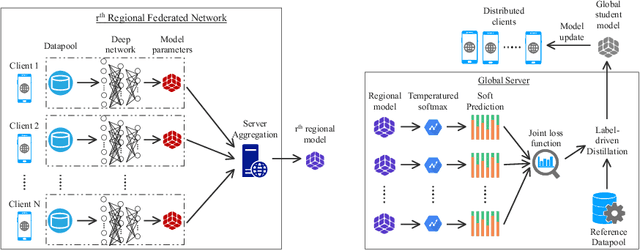


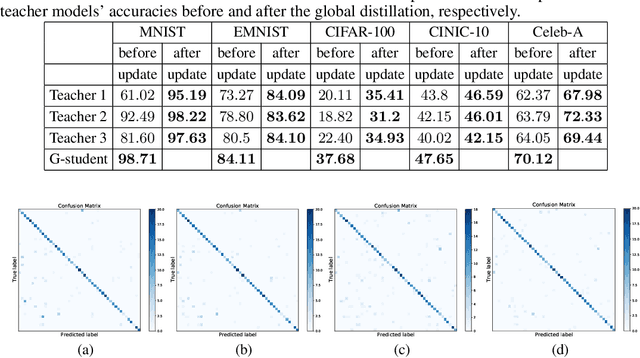
Abstract:In real-world applications, Federated Learning (FL) meets two challenges: (1) scalability, especially when applied to massive IoT networks; and (2) how to be robust against an environment with heterogeneous data. Realizing the first problem, we aim to design a novel FL framework named Full-stack FL (F2L). More specifically, F2L utilizes a hierarchical network architecture, making extending the FL network accessible without reconstructing the whole network system. Moreover, leveraging the advantages of hierarchical network design, we propose a new label-driven knowledge distillation (LKD) technique at the global server to address the second problem. As opposed to current knowledge distillation techniques, LKD is capable of training a student model, which consists of good knowledge from all teachers' models. Therefore, our proposed algorithm can effectively extract the knowledge of the regions' data distribution (i.e., the regional aggregated models) to reduce the divergence between clients' models when operating under the FL system with non-independent identically distributed data. Extensive experiment results reveal that: (i) our F2L method can significantly improve the overall FL efficiency in all global distillations, and (ii) F2L rapidly achieves convergence as global distillation stages occur instead of increasing on each communication cycle.
HCFL: A High Compression Approach for Communication-Efficient Federated Learning in Very Large Scale IoT Networks
Apr 14, 2022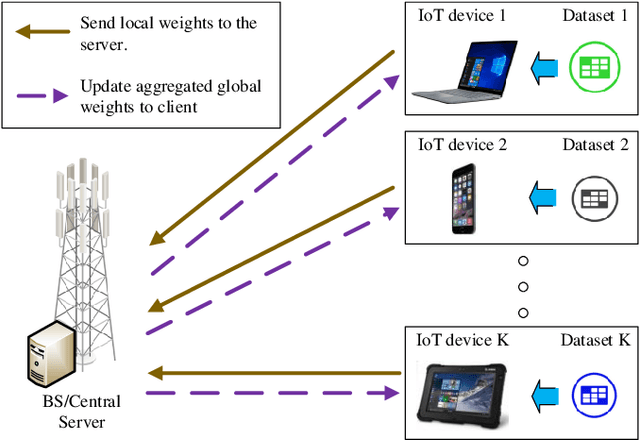
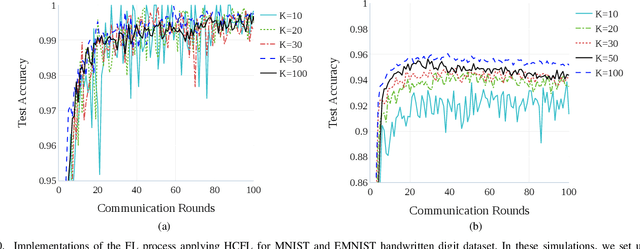
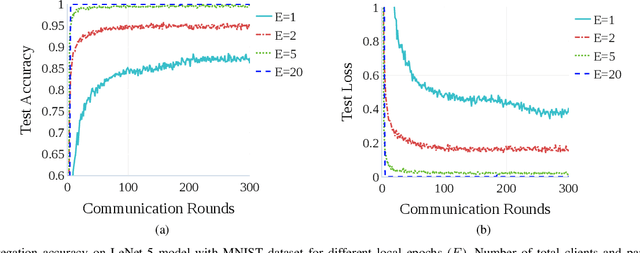
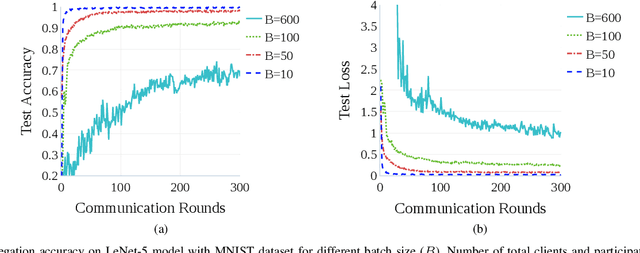
Abstract:Federated learning (FL) is a new artificial intelligence concept that enables Internet-of-Things (IoT) devices to learn a collaborative model without sending the raw data to centralized nodes for processing. Despite numerous advantages, low computing resources at IoT devices and high communication costs for exchanging model parameters make applications of FL in massive IoT networks very limited. In this work, we develop a novel compression scheme for FL, called high-compression federated learning (HCFL), for very large scale IoT networks. HCFL can reduce the data load for FL processes without changing their structure and hyperparameters. In this way, we not only can significantly reduce communication costs, but also make intensive learning processes more adaptable on low-computing resource IoT devices. Furthermore, we investigate a relationship between the number of IoT devices and the convergence level of the FL model and thereby better assess the quality of the FL process. We demonstrate our HCFL scheme in both simulations and mathematical analyses. Our proposed theoretical research can be used as a minimum level of satisfaction, proving that the FL process can achieve good performance when a determined configuration is met. Therefore, we show that HCFL is applicable in any FL-integrated networks with numerous IoT devices.
AI-empowered Joint Communication and Radar Systems with Adaptive Waveform for Autonomous Vehicles
Feb 23, 2022



Abstract:In Joint Communication and Radar (JCR)-based Autonomous Vehicle (AV) systems, optimizing waveform structure is one of the most challenging tasks due to strong influences between radar and data communication functions. Specifically, the preamble of a data communication frame is typically leveraged for the radar function. As such, the higher number of preambles in a Coherent Processing Interval (CPI) is, the greater radar's performance is. In contrast, communication efficiency decreases as the number of preambles increases. Moreover, AVs' surrounding radio environments are usually dynamic with high uncertainties due to their high mobility, making the JCR's waveform optimization problem even more challenging. To that end, this paper develops a novel JCR framework based on the Markov decision process framework and recent advanced techniques in deep reinforcement learning. By doing so, without requiring complete knowledge of the surrounding environment in advance, the JCR-AV can adaptively optimize its waveform structure (i.e., number of frames in the CPI) to maximize radar and data communication performance under the surrounding environment's dynamic and uncertainty. Extensive simulations show that our proposed approach can improve the joint communication and radar performance up to 46.26% compared with those of conventional methods (e.g., greedy policy- and fixed waveform-based approaches).
Federated Learning for Smart Healthcare: A Survey
Nov 16, 2021



Abstract:Recent advances in communication technologies and Internet-of-Medical-Things have transformed smart healthcare enabled by artificial intelligence (AI). Traditionally, AI techniques require centralized data collection and processing that may be infeasible in realistic healthcare scenarios due to the high scalability of modern healthcare networks and growing data privacy concerns. Federated Learning (FL), as an emerging distributed collaborative AI paradigm, is particularly attractive for smart healthcare, by coordinating multiple clients (e.g., hospitals) to perform AI training without sharing raw data. Accordingly, we provide a comprehensive survey on the use of FL in smart healthcare. First, we present the recent advances in FL, the motivations, and the requirements of using FL in smart healthcare. The recent FL designs for smart healthcare are then discussed, ranging from resource-aware FL, secure and privacy-aware FL to incentive FL and personalized FL. Subsequently, we provide a state-of-the-art review on the emerging applications of FL in key healthcare domains, including health data management, remote health monitoring, medical imaging, and COVID-19 detection. Several recent FL-based smart healthcare projects are analyzed, and the key lessons learned from the survey are also highlighted. Finally, we discuss interesting research challenges and possible directions for future FL research in smart healthcare.
Secure Swarm UAV-assisted Communications with Cooperative Friendly Jamming
Jul 29, 2021



Abstract:This article proposes a cooperative friendly jamming framework for swarm unmanned aerial vehicle (UAV)-assisted amplify-and-forward (AF) relaying networks with wireless energy harvesting. Due to the limited energy of the UAVs, we develop a collaborative time-switching relaying protocol which allows the UAVs to collaborate to harvest wireless energy, relay information, and jam the eavesdropper. To evaluate the secrecy rate, we derive the secrecy outage probability (SOP) for two popular detection techniques at the eavesdropper, i.e., selection combining and maximum-ratio combining. Monte Carlo simulations are then used to validate the theoretical SOP derivation and to show the effectiveness of the proposed framework in terms of SOP as compared with the conventional amplify-and-forward relaying system. Using the derived SOP, one can obtain engineering insights to optimize the energy harvesting time and the number of UAVs in the swarm to achieve a given secrecy protection level. The analytical SOP derived in this work can also be helpful in future UAV secure-communications optimizations (e.g., trajectory, locations of UAVs). As an example, we present a case study to find the optimal corridor to locate the swarm so as to minimize the system SOP.
UAV Communications for Sustainable Federated Learning
Mar 20, 2021


Abstract:Federated learning (FL), invented by Google in 2016, has become a hot research trend. However, enabling FL in wireless networks has to overcome the limited battery challenge of mobile users. In this regard, we propose to apply unmanned aerial vehicle (UAV)-empowered wireless power transfer to enable sustainable FL-based wireless networks. The objective is to maximize the UAV transmit power efficiency, via a joint optimization of transmission time and bandwidth allocation, power control, and the UAV placement. Directly solving the formulated problem is challenging, due to the coupling of variables. Hence, we leverage the decomposition technique and a successive convex approximation approach to develop an efficient algorithm, namely UAV for sustainable FL (UAV-SFL). Finally, simulations illustrate the potential of our proposed UAV-SFL approach in providing a sustainable solution for FL-based wireless networks, and in reducing the UAV transmit power by 32.95%, 63.18%, and 78.81% compared with the benchmarks.
 Add to Chrome
Add to Chrome Add to Firefox
Add to Firefox Add to Edge
Add to Edge